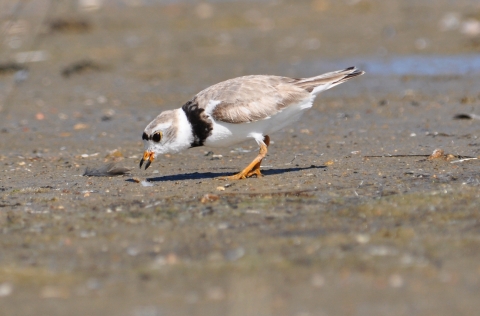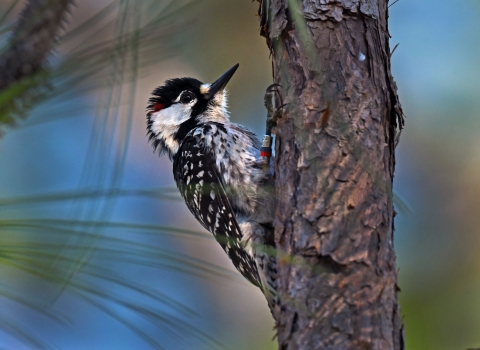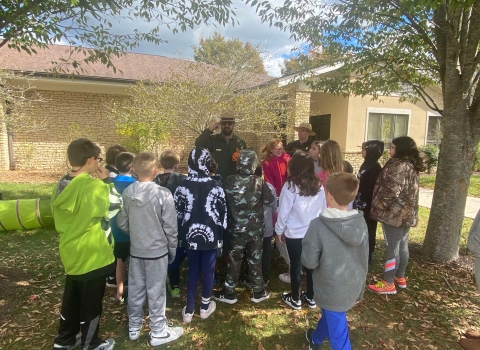The piping plover is an adorable, small shorebird that charms anyone who spots its tiny, sand-colored form scurrying along the beach. With its bright, expressive eyes and a distinctive black band across its forehead, this little bird seems almost whimsical as it dances near the water's edge.
With its light-colored plumage that blends seamlessly with its coastal habitat, the piping plover faces numerous challenges, including habitat loss, human disturbance, and predation. As conservationists strive to protect and restore its breeding grounds, the piping plover's story underscores the delicate balance between wildlife and human activity in fragile ecosystems.
Description
The piping plover is a sparrow-sized, plump bird. Its light, sandy color blends in with the coastal sandy and gravel beaches where it feeds and nests. Piping plovers have a black necklace across their chest and a black stripe across their forehead. The bird’s underparts are white, and it has orange legs and an orange bill with a black tip. When plovers are in flight, a white wing stripe is visible.
Location and Status
There are three populations of piping plover subspecies in North America. One population is found on the shorelines of the Great Lakes. Another population exists along the rivers and lakes in the Northern Great Plains. The third subspecies occurs along the Atlantic Coast. All three subspecies migrate south to winter on the southern Atlantic and Gulf coasts, and in the Bahamas and Cuba.
In December 1985, the Atlantic Coast and Northern Great Plains populations were listed as threatened, and the population in the Great Lakes watershed was listed as endangered.
Characteristics
The piping plover’s lifespan extends for five or six years, but they can live up to 11 years. They feast on invertebrates. To feed, plovers use a foot trembling dance: Running in short, quick bursts, the plover stops and extends one foot to rapidly pat the sand. The resulting vibrations are thought to bring their prey to the surface. They forage alone or in small groups. These birds on nest on open sandy or gravel beaches and alkaline flats; and they winter on beaches and mudflats.
Where can you find piping plovers?
If you’re hoping to add the piping plover to your birdwatching life list, a trip to National Wildlife Refuge is in order! These birds have been observed at the following National Wildlife Refuges:
- Merritt Island National Wildlife Refuge, Florida: Merritt Island National Wildlife Refuge is strategically located on the Atlantic Flyway, a major bird migration corridor, and it is a key resting stop for many migratory bird species.
- Cabo Rojo National Wildlife Refuge, Puerto Rico: The Cabo Rojo Salt Flats is the first site in the Caribbean to be designated by the Western Hemisphere Shorebird Reserve Network. This site is also designated by BirdLife International as an Important Bird Area.
- Bald Knob National Wildlife Refuge, Arkansas: Provides the piping plover and other migratory shorebirds with the ideal mudflat habitat for foraging as they pass through Arkansas. To create mudflats, refuge staff members hold water at a certain depth to inhibit plant growth throughout the spring and early summer and then in late summer, drop the water levels to expose the mudflats. This attracts thousands of shorebirds to the refuge each year in August.
Piping Plover Photo Contest
As part of our Bird of the Month series, we invite you to submit your photos of piping plovers in a photo contest.
**In the file name of your photo, please include your first and last name, contact email address, and the location where the photo was taken. If these components are missing, we will have no way of contacting you if you win.**
Submissions will be judged by a panel of U.S. Fish and Wildlife Service employees. Once a winner is selected, they will be contacted via email and asked to sign a photo release form. This form protects the photographer's rights, ensures proper credits are given, and grants the U.S. Fish and Wildlife Service permission to share the photo on our social media channels. Please monitor your junk/spam folders towards the end of the month in the event that we reach out and our email lands there.
The winner will be announced publicly near the end of each month on our Southeast Regional Facebook and X (formerly known as Twitter) platforms.
A photo contest will occur each month for each featured bird species. At the end of 2024, all twelve winning photographs will be shared on our regional social media accounts.
Submit your original photos of piping plovers here!
Fun Facts About Mudflats
Mudflats feed migratory shorebirds, like the piping plover!
What are mudflats: Mudflats or tidal flats form when silt, clay, and mud are transported by seas, oceans, or tributaries and are deposited and settle into bays and lagoons when the tide comes in. Mudflats are constantly flooded at high tides or exposed during low tides.
Nature’s restaurant: Southward migrating shorebirds dig into the mudflats with their bills to feast on mussels, snails, oysters, crabs, lugworms, and fish.
Earth’s kidneys: Mudflats filter and absorb sediment, nutrients, and pollutants from the surrounding land and water.
Rotten eggs and Quicksand: Although they provide a smorgasbord for shorebirds, mudflats smell like rotten eggs. Upper layers of mudflats contain oxygen. The lower layers are composed of decaying invertebrates and bacteria that release a hydrogen sulfide gas. Mudflats are also dangerous to walk on. The silt, clay, or mud that settles into mudflats also contains trapped water which gels into quicksand when walked on. Mudflats also flood at high tide.










